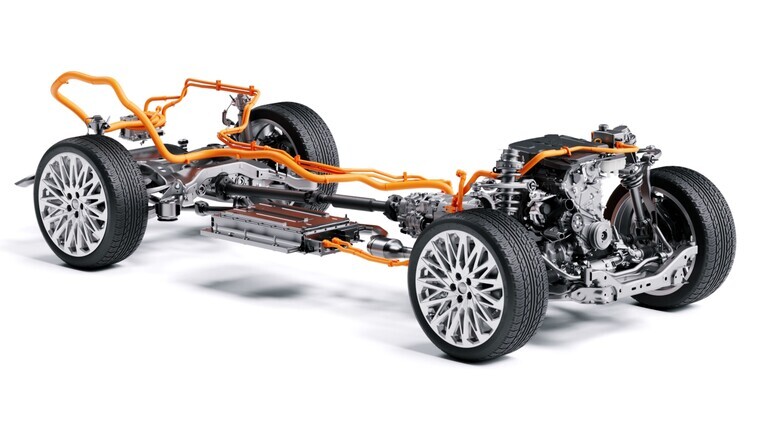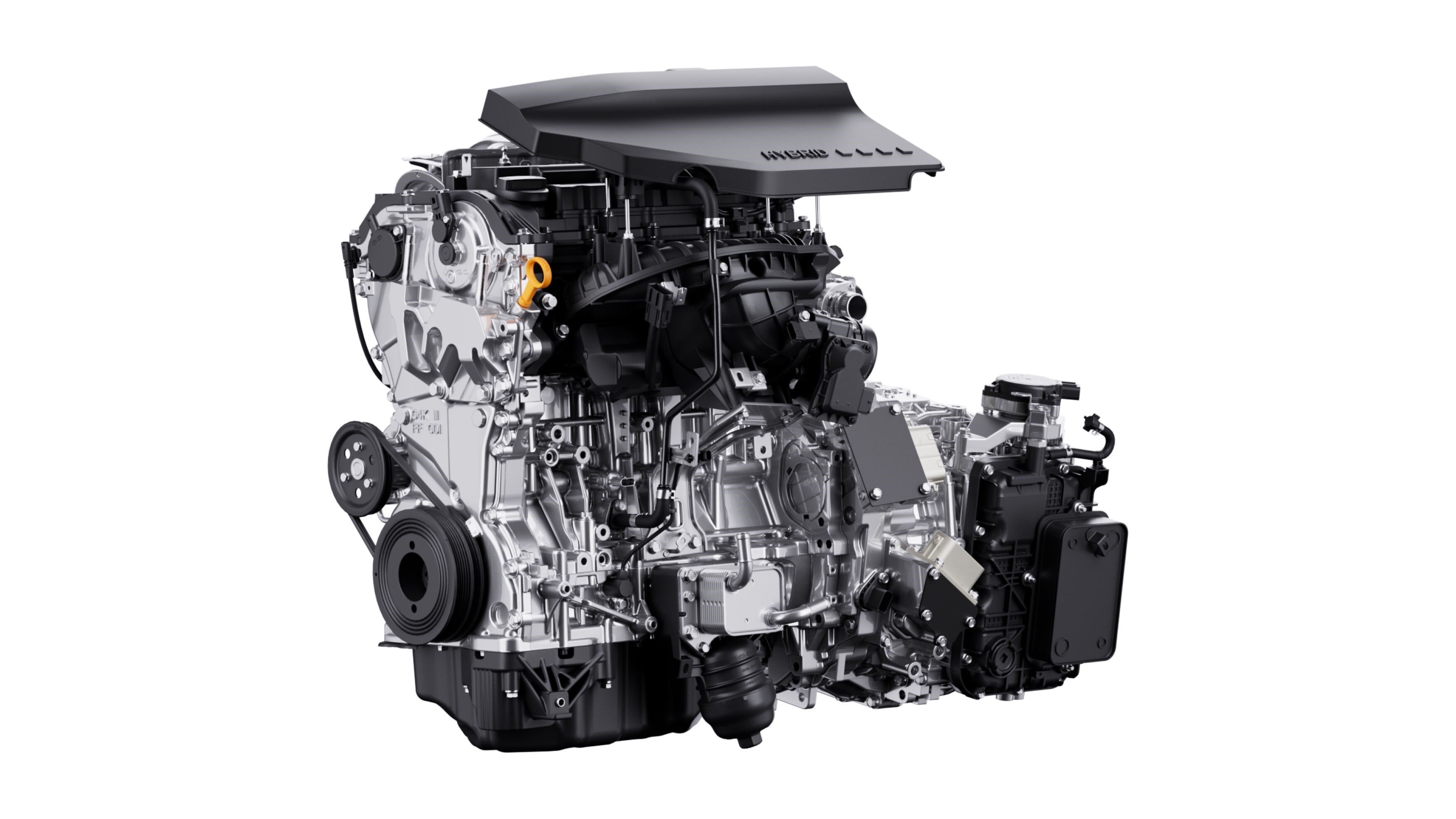Next-gen boost for hybrids

Hyundai Motor Group has unveiled its next-generation hybrid powertrain system to deliver a new standard for power and efficiency.
With the advanced system, it plans to offer a range of industry-leading new products in the hybrid segment.
It features a new transmission with two integrated motors that can be paired flexibly with a range of internal combustion engines (ICEs), allowing for optimised performance and fuel efficiency across various classes.
Additionally, electrification-focused technologies have been incorporated into the next-generation hybrid system, pictured above, to enhance driving performance, refinement and comfort.
The transmission includes a new P1 motor that handles starting, battery-energy generation and energy deployment to assist propulsion.
Its P2 driving motor covers propulsion and regenerative braking.
This integrated dual-motor set-up improves power, performance and fuel efficiency while achieving smooth shifting and reduced noise and vibrations.
The transmission can be paired flexibly with ICEs to deliver system output from the low-73kW range to the mid-220-kW region allowing for broad application from sub-compact to large vehicles.
The group has employed its experience with hybrid powertrains – and motor and battery-control technology accumulated by developing its dedicated E-GMP electric vehicle platform – to enhance performance and comfort.
The new hybrid system also integrates convenience features commonly found in the Hyundai’s EVs, such as stay mode, vehicle-to-load (V2L) functionality and smart regenerative braking.
Improved engine design
The first powertrain to use the hybrid system has a newly developed petrol 2.5-litre turbo hybrid unit, pictured below. It improves the design and control technology of the existing 2.5-litre turbo petrol to maximise efficiency. A next-generation petrol 1.6-litre turbo hybrid powertrain will also be available.
By reassigning the 2.5’s starting and generating tasks to the added P1 motor, the turbo hybrid powertrain minimises power losses.
Combined with enhanced cylinder flow in the engine and adopting a high-efficiency cycle optimised for hybrids, fuel efficiency has been boosted.
Typically, ICEs generate power through four strokes – intake, compression, combustion and exhaust. The 2.5-turbo hybrid system utilises an “over-expansion cycle”.
This intentionally delays intake valve closure during compression to lower the effective compression ratio of the mixed gas in the cylinder while maintaining a high expansion ratio during the combustion process.
The technique reduces power consumption during mixture compression while maximising energy generated after combustion, significantly enhancing engine efficiency.
 Additionally, an improved piston design and expanded triple fuel-injection range enhances combustion speed, stabilises combustion and suppresses detonation to further improve engine efficiency.
Additionally, an improved piston design and expanded triple fuel-injection range enhances combustion speed, stabilises combustion and suppresses detonation to further improve engine efficiency.
Focusing on the P1+P2 parallel structure and ICE improvements, fuel efficiency and power performance have been enhanced while achieving smoother shifting and improved powertrain refinement.
By connecting the P1 motor directly to the engine, the system reduces start time. Precise control of engine load, and the driving force of the P1 and P2 motors, ensure the engine operates within a high-efficiency range.
The petrol 2.5-litre turbo hybrid system used in the all-new Palisade delivers maximum fuel efficiency of 7.1l/100km, a maximum system output of 245kW and top torque of 460Nm. The result is about 45 per cent greater fuel efficiency, 19 per cent more maximum power and a nine per cent improvement in maximum torque compared with a 2.5-turbo petrol model.
The next-generation petrol 1.6-litre turbo hybrid improves fuel efficiency by more than four per cent in a mid-size SUV compared with previous models, increasing the system’s maximum rated torque output from 367Nm to 380Nm and improving acceleration response.
Additionally, by incorporating the P1 motor into the active shift-control hybrid transmission logic, it achieves faster and smoother shifting performance.
Enhanced control of the engine clutch further reduces time taken for the engine to engage when switching from EV mode. The P1 motor is also utilised to cut engine vibration and booming during battery charging while idle.
Electrification technologies
Alongside the next-generation hybrid powertrain, Hyundai will integrate advanced electrification technologies to enhance performance, efficiency and competitiveness in its new hybrids.
Its line-up of electrification-focused technologies comprises electric all-wheel drive (e-AWD), electrification vehicle motion control (e-VMC 2.0), e-handling 2.0, electrification-evasive handling assist (e-EHA 2.0), e-ride 2.0, stay mode, V2L and smart regenerative braking.
The e-AWD system adds a P4 driving motor to the rear axle on vehicles equipped with this technology, improving driving performance and acceleration response. The group plans to offer e-AWD and conventional mechanical AWD, offering the optimal AWD configuration according to vehicle class and regional requirements.
e-VMC 2.0 is available on hybrids fitted with e-AWD, enhancing stability and ride comfort through independent torque control of the front and rear driving motors. It comprises e-handling 2.0, e-EHA 2.0, and e-ride 2.0.
e-handling 2.0 enhances roll prevention during cornering by controlling the front and rear motors, applying motor torque in opposite directions to lower the vehicle’s centre of gravity. While the original system increased driving stability and responsiveness through single-motor acceleration and deceleration control, version 2.0 offers even more refined control.
e-EHA 2.0 is an emergency steering-assist technology that utilises radar and camera sensors to detect potential frontal collisions. It refines evasive manoeuvres through precise braking control of the front and rear motors during sudden steering by the driver.
Particularly after emergency steering inputs, e-EHA 2.0 assists by using the front motor for forward propulsion while braking the rear motor to lower the car’s centre of gravity.
e-Ride 2.0 maximises comfort by minimising vertical movements going over speed bumps. It leverages changes in the vehicle's centre of gravity through opposite directional control of the motors during speed-bump entry and exit.
Stay mode adapts the “utility mode” of EVs for hybrid models, enabling a more pleasant time inside the vehicle when stationary by utilising the high-voltage battery.
This mode allows the use of all in-vehicle convenience features, including air-conditioning and multimedia, without starting the engine. It can be used for up to 60 minutes when the battery’s state of charge is between 70 and 80 per cent.
This system also includes a “stay mode-usage reservation” feature. This synchronises with the navigation system and begins charging the high-voltage battery about 2km before reaching a user’s intended destination, targeting a charge level of 70 to 80 per cent on arrival to maximise stay mode usage.
Additionally, the next-generation hybrid system’s V2L function offers a maximum output of 3.6kW, similar to EVs, so users can power up external appliances and personal tech devices. V2L can be used continuously while the engine is running and in stay mode with the engine off. In this use case, up to 50 per cent battery capacity – from 80-30 per cent – can be utilised.
Other technologies introduced with the next-generation hybrid system include hierarchical predictive control and smart regenerative braking. The former optimally controls battery charge by predicting the driving route and road conditions, and selecting the best driving mode along the way for improved fuel efficiency.
Smart regenerative braking automatically applies optimal regenerative-braking force based on navigation data and distance to other vehicles ahead, reducing brake-pedal inputs and increasing battery charge through regenerative braking.
Hybrid line-up to expand
Hyundai plans to combine its new hybrid transmission with various engines across a system output from the low-73kW range to the mid-220kW region into a “diverse” line-up of hybrids from compact to large and luxury.
With expanded system output coverage, its hybrid powertrain range will increase from three models to five. The latest 2.5-litre turbo hybrid powertrain is making its debut in the all-new Palisade hybrid. It will be applied to other Hyundai and Kia models in the future.
The group plans to introduce a rear-wheel-drive 2.5 turbo hybrid system in 2026 and aims to expand its hybrid technology to the Genesis luxury brand by applying this powertrain to key models over time.
For all future hybrids, the group plans to apply the new hybrid system and further electrification-focused technologies, tailoring these to the characteristics of vehicles and classes, and regional market requirements.





